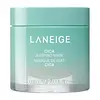What's inside
What's inside
 Key Ingredients
Key Ingredients

 Benefits
Benefits

 Concerns
Concerns

 Ingredients Side-by-side
Ingredients Side-by-side

Water
Skin ConditioningGlycerin
HumectantSqualane
EmollientButylene Glycol
HumectantCetearyl Alcohol
EmollientDicaprylyl Carbonate
Emollient1,2-Hexanediol
Skin ConditioningButylene Glycol Dicaprylate/Dicaprate
EmollientPentaerythrityl Tetraethylhexanoate
EmollientPolyglyceryl-3 Methylglucose Distearate
EmulsifyingHydrogenated Coco-Glycerides
EmollientPolyglyceryl-3 Distearate
EmulsifyingGlyceryl Stearate
EmollientPanthenol
Skin ConditioningAmmonium Acryloyldimethyltaurate/Vp Copolymer
Cetearyl Glucoside
EmulsifyingLactobacillus Ferment
Skin ConditioningPolyacrylate Crosspolymer-6
Emulsion StabilisingLactobacillus Ferment Lysate
Skin ConditioningPropanediol
SolventNiacinamide
SmoothingEthylhexylglycerin
Skin ConditioningGlyceryl Stearate Citrate
EmollientAllantoin
Skin ConditioningSodium Stearoyl Glutamate
CleansingDipotassium Glycyrrhizate
HumectantSodium Metaphosphate
BufferingMadecassoside
AntioxidantEctoin
Skin ConditioningDextrin
AbsorbentTheobroma Cacao Extract
Skin ConditioningBeta-Glucan
Skin ConditioningAsiaticoside
AntioxidantMadecassic Acid
Skin ConditioningAsiatic Acid
Skin ConditioningTocopherol
AntioxidantCentella Asiatica Flower/Leaf/Stem Extract
Skin ConditioningHydrolyzed Vegetable Protein
Skin Conditioning7-Dehydrocholesterol
Emulsion StabilisingInonotus Obliquus Extract
Skin ConditioningWater, Glycerin, Squalane, Butylene Glycol, Cetearyl Alcohol, Dicaprylyl Carbonate, 1,2-Hexanediol, Butylene Glycol Dicaprylate/Dicaprate, Pentaerythrityl Tetraethylhexanoate, Polyglyceryl-3 Methylglucose Distearate, Hydrogenated Coco-Glycerides, Polyglyceryl-3 Distearate, Glyceryl Stearate, Panthenol, Ammonium Acryloyldimethyltaurate/Vp Copolymer, Cetearyl Glucoside, Lactobacillus Ferment, Polyacrylate Crosspolymer-6, Lactobacillus Ferment Lysate, Propanediol, Niacinamide, Ethylhexylglycerin, Glyceryl Stearate Citrate, Allantoin, Sodium Stearoyl Glutamate, Dipotassium Glycyrrhizate, Sodium Metaphosphate, Madecassoside, Ectoin, Dextrin, Theobroma Cacao Extract, Beta-Glucan, Asiaticoside, Madecassic Acid, Asiatic Acid, Tocopherol, Centella Asiatica Flower/Leaf/Stem Extract, Hydrolyzed Vegetable Protein, 7-Dehydrocholesterol, Inonotus Obliquus Extract
Water
Skin ConditioningPropanediol
SolventPolyglycerin-3
HumectantGlycerin
HumectantMethyl Gluceth-20
Humectant1,2-Hexanediol
Skin ConditioningHydroxyethylpiperazine Ethane Sulfonic Acid
BufferingMadecassoside
AntioxidantAllantoin
Skin ConditioningBeta-Glucan
Skin ConditioningAlanyl Glutamine
HumectantAcetyl Hexapeptide-8
HumectantButylene Glycol
HumectantXanthan Gum
EmulsifyingAcrylates/C10-30 Alkyl Acrylate Crosspolymer
Emulsion StabilisingTromethamine
BufferingTrisodium EDTA
Caprylyl Glycol
EmollientBis-PEG-18 Methyl Ether Dimethyl Silane
EmollientPEG-40 Hydrogenated Castor Oil
EmulsifyingPelargonium Graveolens Flower Oil
MaskingCitrus Aurantifolia Oil
CleansingRosmarinus Officinalis Leaf Oil
MaskingCitrus Aurantium Bergamia Fruit Oil
MaskingMelaleuca Alternifolia Leaf Oil
AntioxidantEucalyptus Globulus Leaf Oil
PerfumingWater, Propanediol, Polyglycerin-3, Glycerin, Methyl Gluceth-20, 1,2-Hexanediol, Hydroxyethylpiperazine Ethane Sulfonic Acid, Madecassoside, Allantoin, Beta-Glucan, Alanyl Glutamine, Acetyl Hexapeptide-8, Butylene Glycol, Xanthan Gum, Acrylates/C10-30 Alkyl Acrylate Crosspolymer, Tromethamine, Trisodium EDTA, Caprylyl Glycol, Bis-PEG-18 Methyl Ether Dimethyl Silane, PEG-40 Hydrogenated Castor Oil, Pelargonium Graveolens Flower Oil, Citrus Aurantifolia Oil, Rosmarinus Officinalis Leaf Oil, Citrus Aurantium Bergamia Fruit Oil, Melaleuca Alternifolia Leaf Oil, Eucalyptus Globulus Leaf Oil
Ingredients Explained
These ingredients are found in both products.
Ingredients higher up in an ingredient list are typically present in a larger amount.
1,2-Hexanediol is a synthetic liquid and another multi-functional powerhouse.
It is a:
- Humectant, drawing moisture into the skin
- Emollient, helping to soften skin
- Solvent, dispersing and stabilizing formulas
- Preservative booster, enhancing the antimicrobial activity of other preservatives
Allantoin is a soothing ingredient known for its protective and moisturizingg properties. Because of this, it is often added to products with strong active ingredients.
Studies show higher concentrations of this ingredient can promote wound healing.
Though it can be derived from the comfrey plant, allantoin is produced synthetically for cosmetic products to ensure purity.
Learn more about AllantoinBeta-Glucan is a polysaccharide. It can be derived from the cell walls of seaweed, oats, yeast, and fungi. It hydrates the skin and helps boost your skin's natural barrier.
As an antioxidant, beta-glucan helps fight free-radicals. Free-radicals are molecules that may damage your skin cells, such as pollution.
Studies show this ingredient may be an effective wrinkle reducer as it can deeply penetrate into skin. It has also been show to help with wound healing.
Learn more about Beta-GlucanButylene Glycol (or BG) is used within cosmetic products for a few different reasons:
Overall, Butylene Glycol is a safe and well-rounded ingredient that works well with other ingredients.
Though this ingredient works well with most skin types, some people with sensitive skin may experience a reaction such as allergic rashes, closed comedones, or itchiness.
Learn more about Butylene GlycolGlycerin is already naturally found in your skin. It helps moisturize and protect your skin.
A study from 2016 found glycerin to be more effective as a humectant than AHAs and hyaluronic acid.
As a humectant, it helps the skin stay hydrated by pulling moisture to your skin. The low molecular weight of glycerin allows it to pull moisture into the deeper layers of your skin.
Hydrated skin improves your skin barrier; Your skin barrier helps protect against irritants and bacteria.
Glycerin has also been found to have antimicrobial and antiviral properties. Due to these properties, glycerin is often used in wound and burn treatments.
In cosmetics, glycerin is usually derived from plants such as soybean or palm. However, it can also be sourced from animals, such as tallow or animal fat.
This ingredient is organic, colorless, odorless, and non-toxic.
Glycerin is the name for this ingredient in American English. British English uses Glycerol/Glycerine.
Learn more about GlycerinMadecassoside comes from the super popular skin-soothing ingredient, Centella asiatica. It is one of four active compounds found in the extract of Centella Asiatica.
Madecassoside has antioxidant, anti-inflammatory, and hydrating properties. It contains fatty acids, amino acids, beta-carotene, and phytochemicals.
One study found using Madecassoside with ascorbic acid helped reduce the signs of aging and improved skin hydration.
Learn more about MadecassosidePropanediol is an all-star ingredient. It softens, hydrates, and smooths the skin.
It’s often used to:
Propanediol is not likely to cause sensitivity and considered safe to use. It is derived from corn or petroleum with a clear color and no scent.
Learn more about PropanediolWater. It's the most common cosmetic ingredient of all. You'll usually see it at the top of ingredient lists, meaning that it makes up the largest part of the product.
So why is it so popular? Water most often acts as a solvent - this means that it helps dissolve other ingredients into the formulation.
You'll also recognize water as that liquid we all need to stay alive. If you see this, drink a glass of water. Stay hydrated!
Learn more about Water